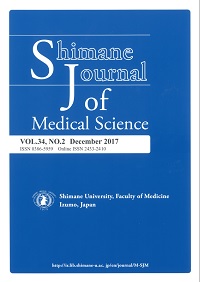Shimane University Faculty of Medicine
ISSN :0386-5959(in print)
ISSN :2433-2410(online)


These article are licensed under a Creative Commons Attribution-NonCommercial-NoDerivatives 4.0 International License.
number of downloads : ?
Use this link to cite this item : https://ir.lib.shimane-u.ac.jp/34590
Shimane Journal of Medical Science 8 1
1984-06-01 発行
Hemodynamic Effects of Epidural Analgesia for Gastrectomy in the Geriatric Patient
Kosaka, Yoshihiro
Matsui, Kazuyuki
Nishio, Yuji
Shiihara, Kohya
File
Description
The hemodynamic effect of epidural analgesia supplemented with a small dose of sedatives was studied by Swan-Ganz Catheter method in fifteen geriatric patients from 65 to 80 years old with gastrectomy. No premedication was given to avoid its circulatory effects. From one venous route 5 ml/kg/hr of lactated Ringer solution and from the other hydroxyethyl starch at the same rate were infused. Epidural puncture was performed in the intervertebral space between T_8 and T_<10> and 6 to 8 ml of 2% mepivacaine were administered through the epidural catheter. Analgesia by epidural block 20 min later was in average from T_2 to L_1. Hemodynamic parameters were assessed before, 20 min after epidural block, and 5 and 20 min after diazepam (5mg). After 20 min of epidural analgesia, HR (-5%), MAP (-19%), SVR (-16%), and RPP (-28%) decreased significantly, while MPAP, CVP, CI, SVI and PVR did not change. Five minutes after diazepam, hemodynamic parameters decreased by 10% more. These changes, however, returned to the pre-administration level 20 min after diazepam. Though meticulous caution is needed for intraoperative management from a circulatory and respiratory standpoint, we consider epidural analgesia to be one of the recommendable anesthetic methods for the anesthesia of gastrectomy in elderly patients.
About This Article
Other Article
PP. 45 - 56
